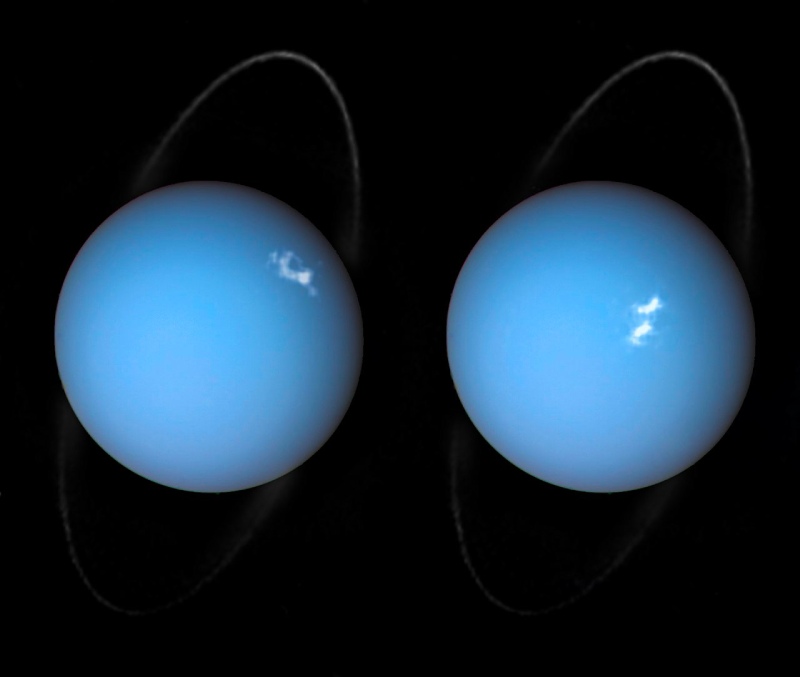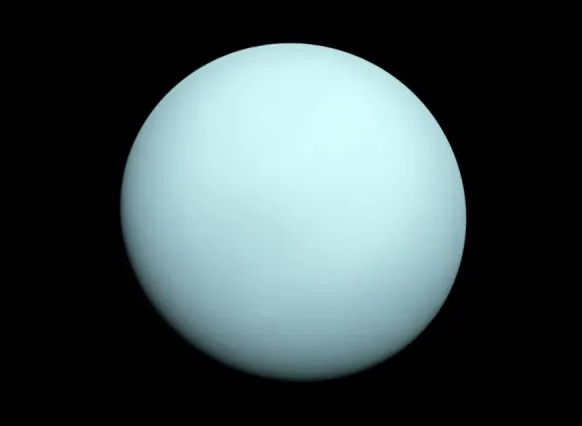Uranus is the seventh planet from the Sun in our solar system and is known for its unique characteristics, including its sideways rotation and pale blue color. Here are some key details about Uranus:
Size and Distance from the Sun
Uranus has a diameter of approximately 50,724 kilometers (31,518 miles), making it the third-largest planet in our solar system by diameter. The average distance between Uranus and the Sun is about 2.88 billion kilometers (1.79 billion miles), placing it in the outer regions of the solar system.
Composition
Uranus is an ice giant composed mainly of hydrogen, helium, and icy materials such as water, ammonia, and methane. Its atmosphere contains a high concentration of methane, which gives Uranus its pale blue-green color.
Axis Tilt
One of the most distinctive features of Uranus is its extreme axial tilt. While most planets in the solar system have relatively upright axes of rotation, Uranus rotates on its side, with its axis tilted at an angle of about 98 degrees relative to its orbital plane. This unusual axial tilt means that Uranus experiences extreme seasonal variations as it orbits the Sun, with one pole facing the Sun directly while the other pole faces away.
Atmosphere
Uranus has a thick atmosphere composed primarily of hydrogen and helium, with traces of methane and other gases.
The upper atmosphere of Uranus features bands of clouds and high-speed winds, with wind speeds reaching up to 900 kilometers per hour (560 miles per hour).
Temperature
The temperature on Uranus varies depending on factors such as altitude, latitude, and depth within its atmosphere.
In the upper atmosphere of Uranus, temperatures can plummet to extremely cold levels, typically ranging from about -220°C (-364°F) to -210°C (-346°F). The upper atmosphere of Uranus is primarily composed of hydrogen and helium, with traces of methane, which absorbs solar radiation and contributes to the planet’s frigid temperatures.
As you descend deeper into Uranus’s atmosphere, temperatures increase due to the pressure of the overlying gases. At a depth where the atmospheric pressure is comparable to Earth’s surface pressure (about 1 bar), temperatures are estimated to be around -190°C (-310°F) to -160°C (-260°F).
Aurorae
Auroras have also been spotted on the planet. These phenomena occur at both the poles of the planet, driven by its magnetic field and interactions with the solar wind. Although they are not as well-studied as the aurorae on Earth or Jupiter, observations from the Hubble Space Telescope and other instruments have confirmed their presence. The unique tilt of Uranus’s magnetic field and rotation axis contributes to the characteristics of its auroras.
Rings and Moons
Uranus has a system of faint rings composed of dust and rocky debris, similar to those of Saturn but much less prominent. It also has 27 known moons, with the largest moons being Miranda, Ariel, Umbriel, Titania, and Oberon. These moons vary in size, composition, and surface features.

Exploration
Uranus has been visited by only one spacecraft to date: NASA’s Voyager 2 probe, which flew by the planet in 1986. Voyager 2 provided valuable data about Uranus’s atmosphere, rings, and moons, but no further missions to Uranus have been conducted since then.
Uranus remains a fascinating and relatively unexplored world in our solar system, and further study of this enigmatic planet could provide valuable insights into the processes of planetary formation and evolution.
Observation
Observing Uranus can be a bit challenging due to its distance from Earth and its dim appearance in the night sky. However, with the right equipment and knowledge of its location, you can still observe Uranus under favorable conditions.
Uranus is visible to the naked eye, but it appears as a faint, pale blue-green dot in the night sky, dim compared to brighter stars and planets. The best time to observe Uranus is when it is at opposition, which occurs roughly once a year. During opposition, Uranus is on the opposite side of Earth from the Sun, making it visible all night long and at its brightest. However, even at opposition, Uranus is still quite faint and may be challenging to spot without binoculars or a telescope.
Uranus moves slowly across the sky over time due to its orbital motion around the Sun. To find it, you’ll need to know its current position in the sky relative to nearby stars and constellations. You’ll need a dark, clear sky away from light pollution to see faint planets like this one. So try to find a location with minimal light pollution for the best viewing conditions.



